Search Result
Results for "
photodynamic
" in MedChemExpress (MCE) Product Catalog:
3
Biochemical Assay Reagents
| Cat. No. |
Product Name |
Target |
Research Areas |
Chemical Structure |
-
- HY-137473
-
|
Pyropheophorbide-a methyl ester
|
Apoptosis
|
Cancer
|
|
Methyl pyropheophorbide-a (Pyropheophorbide-a methyl ester), a chlorophyll-a derivative, is a potent photosensitizer that can be used in photodynamic therapy (PDT) of cancer. Methyl pyropheophorbide-a has photodynamic activity and can induce apoptosis and inhibit tumor growth .
|
-

-
- HY-W141871
-
-
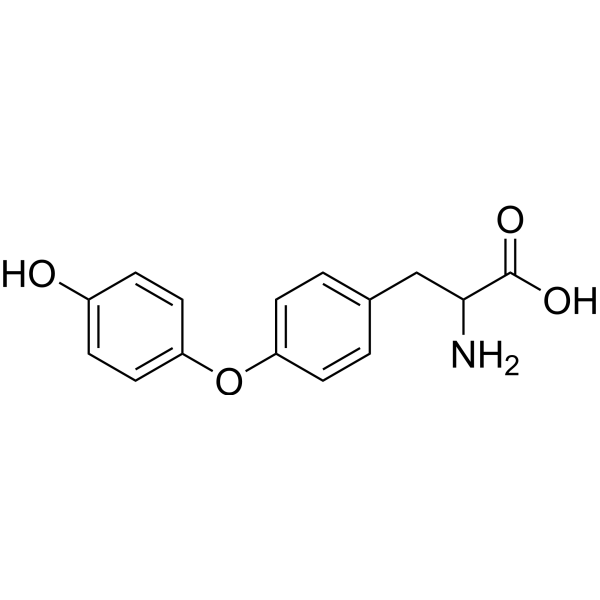
-
- HY-137474
-
|
|
Others
|
Cancer
|
|
Purpurin 18 methyl ester, a chlorophyll-a derivative, is a photosensitizer that can be used in photodynamic therapy (PDT). Purpurin 18 methyl ester has photodynamic activity to induce cancer cell death .
|
-

-
- HY-146416
-
|
|
Others
|
Cancer
|
|
Antitumor photosensitizer-2 (Compound 11) is a potent photosensitizer. Antitumor photosensitizer-2 has outstanding photodynamic anti-tumor effects without obvious skin photo-toxicity, and can act as new agent candidates for photodynamic research .
|
-

-
- HY-146414
-
|
|
Others
|
Cancer
|
|
Antitumor photosensitizer-1 (Compound 8) is a potent photosensitizer. Antitumor photosensitizer-1 has outstanding photodynamic anti-tumor effects without obvious skin photo-toxicity, and can act as new agent candidates for photodynamic research .
|
-

-
- HY-16477
-
|
ME2906; Mono-L-aspartyl chlorin e6; NPe6
|
Others
|
Cancer
|
|
Talaporfin (ME2906) sodium is a chlorin based photosensitizer. Talaporfin sodium can be used for the research of various cancers by using photodynamic therapy (PDT) .
|
-

-
- HY-137475
-
|
|
Reactive Oxygen Species
|
Cancer
|
|
Chlorin e6 trimethyl ester, a methyl pheophorbide-a derivative, is a photosensitizer that can be used in photodynamic therapy (PDT) .
|
-
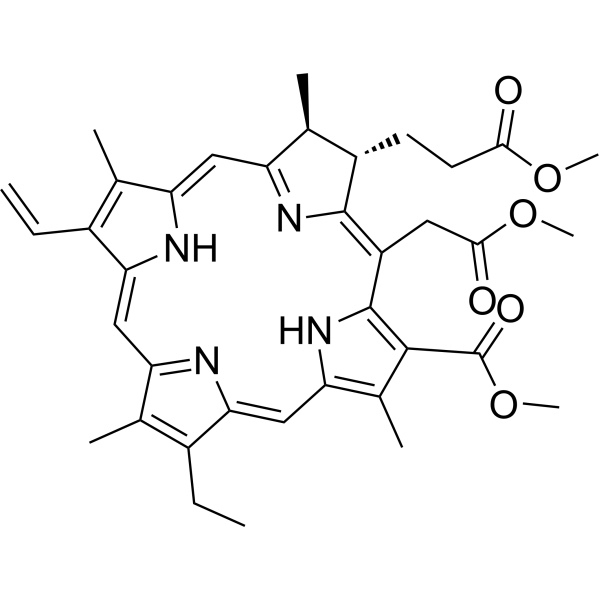
-
- HY-U00128
-
|
|
Parasite
|
Infection
Inflammation/Immunology
|
|
PPA-904 is a specific phenothiazine photosensitizer in photodynamic research (PDT) research, especially topical application for cutaneous leishmaniasis in vivo .
|
-
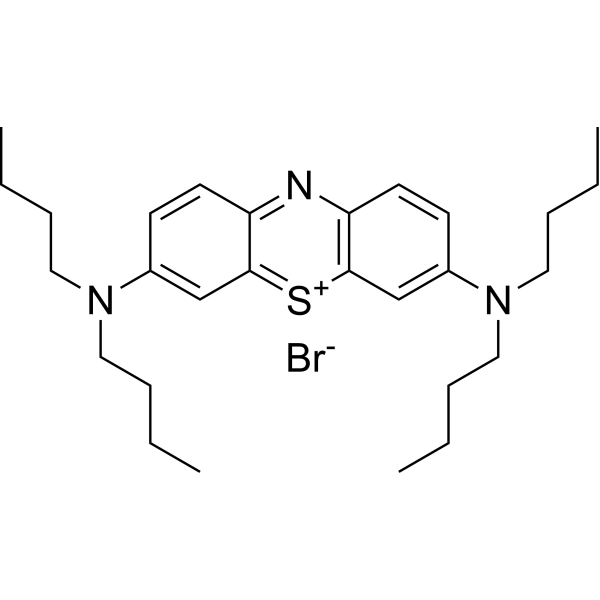
-
- HY-D1452
-
|
|
Fluorescent Dye
|
Cancer
|
|
BDP-4 is an amino acid-modified near-infrared Aza-BODIPY photosensitizer, acts as an immune initiator for potent photodynamic research in melanoma .
|
-

-
- HY-D1453
-
|
|
Biochemical Assay Reagents
|
Cancer
|
|
Immune initiator-1 (Compound 1a) is an amino acid-modified near-infrared Aza-BODIPY photosensitizer, acts as an immune initiator for potent photodynamic research in melanoma .
|
-
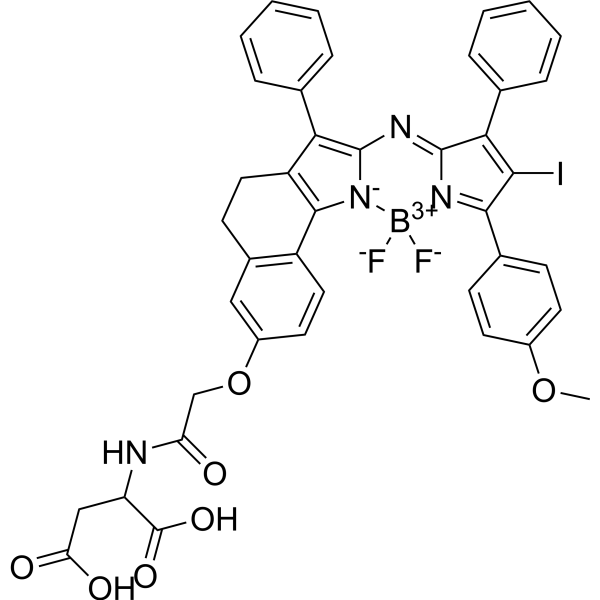
-
- HY-D1299
-
|
CF3-substituted Tetramethyl BODIPY
|
Fluorescent Dye
|
Cancer
|
|
meso-CF3-BODIPY 2 (CF3-substituted Tetramethyl BODIPY) is a fluorescent dye with the absorption wavelength (λabs) of 553 nm and emission wavelength (λem) of 622 nm. meso-CF3-BODIPY 2 can be used in labeling reagents and photodynamic therapy .
|
-

-
- HY-16045
-
|
Hexyl 5-aminolevulinate hydrochloride; P-1206; 5-Aminolevulinic acid hexyl ester hydrochloride
|
Fluorescent Dye
|
Cancer
|
|
Hexaminolevulinate (Hexyl 5-aminolevulinate) hydrochloride, a porphyrin precursor, is a photosensitiser that can be used in photodynamic therapy (PDT) for certain tumor. Hexaminolevulinate hydrochloride can improve the visualisation of bladder tumours .
|
-
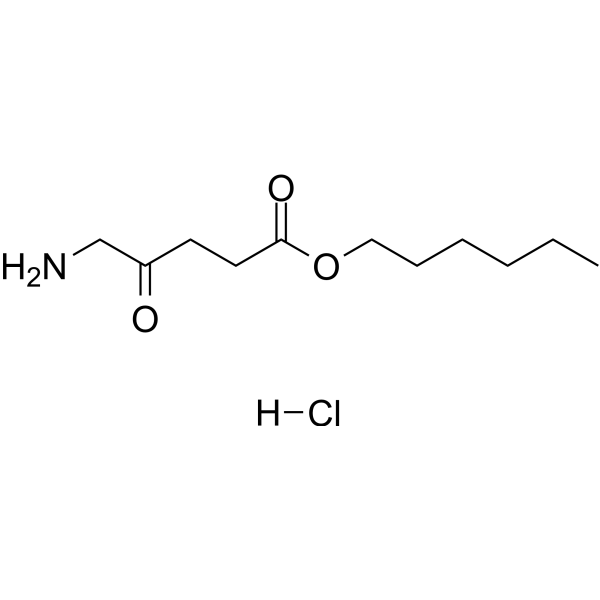
-
- HY-157053
-
|
|
Others
|
Cancer
|
|
[Ru(dppn)2phen](PF6)2 (compound 4) is a polypyridylruthenium compound used in photodynamic therapy (PDT). [Ru(dppn)2phen](PF6)2 is normally nontoxic under dark conditions and induces mitochondrial respiratory damage upon light exposure. [Ru(dppn)2phen](PF6)2 exhibits high levels of singlet oxygen quantum yield and phototoxicity against cancer cells .
|
-
2](//file.medchemexpress.com/product_pic/hy-157053.gif)
-
- HY-157051
-
|
|
Others
|
Cancer
|
|
[Ru(DIP)2TAP]Cl2, Ruthenium(II) polypyridyl compound, is a photosensitizer. [Ru(DIP)2TAP]Cl2 can be used for the research of photodynamic therapy (PDT) .
|
-
![[Ru(DIP)2TAP]Cl2](//file.medchemexpress.com/product_pic/hy-157051.gif)
-
- HY-16488
-
|
m-THPC; KW2345
|
Reactive Oxygen Species
|
Cancer
|
|
Temoporfin (m-THPC), a reduced porphyrin, is a potent second-generation photosensitizer. Temoporfin can be used in the research of photodynamic therapy (PDT) for head and neck cancers .
|
-
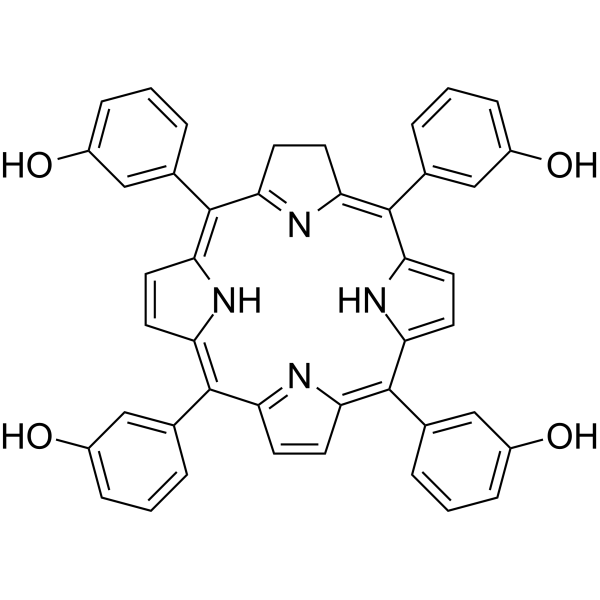
-
- HY-155675
-
|
|
Others
|
Cancer
|
|
TPPC, a porphyrin cholesterol conjugate, can render cancer cells more sensitive to ICIs. TPPC can enhance photodynamic immunotherapy toward lung cancer .
|
-
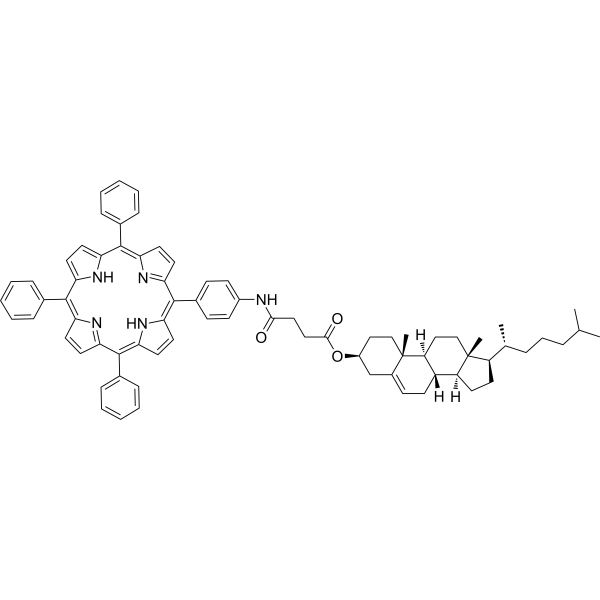
-
- HY-151940
-
|
|
Reactive Oxygen Species
|
Cancer
|
|
Mal-Pc is a versatile molecular photosensitizer designed based phthalocyanine and maleimides. Mal-Pc can react with GSH to deplete GSH and reduce aggregation, thereby improving ROS (Reactive Oxygen Species)-mediated effect of photodynamic therapy (PDT) in cancer cells .
|
-
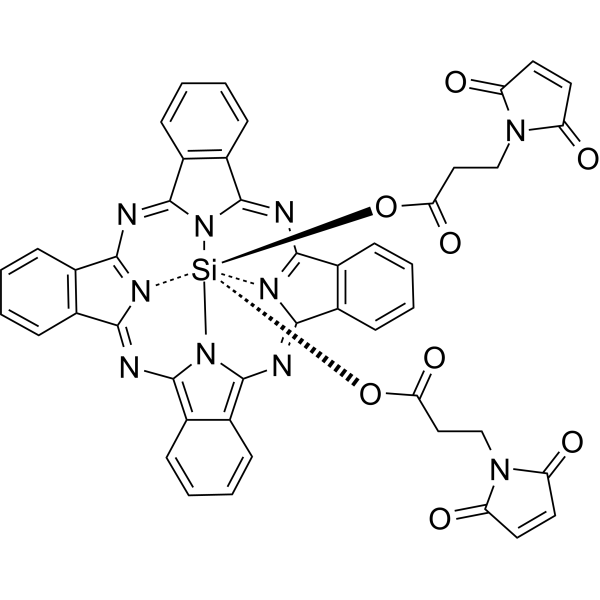
-
- HY-155070
-
|
|
DNA/RNA Synthesis
Apoptosis
|
Cancer
|
|
SRE-II, an amide derivative, is an activatable photosensitizer for photodynamic cancer research with decreased fluorescence and photosensitizing capabilities. SRE-II can be further converted into the active photosensitizer SDU Red via carboxylesterase-catalyzed amide bond cleavage. SRE-II induces DNA damage and cell apoptosis in the presence of light. SRE-II can act as a promising theranostic agent for triple-negative breast cancer .
|
-

-
- HY-W130236
-
|
|
Cholinesterase (ChE)
|
Cancer
|
|
Methylene Violet 3RAX is a phenazine dye to stain the mitochondria of cells. Methylene Violet 3RAX can change the molecular structure of DNA, undermine the module of DNA, and induce the generation of the reactive singlet oxygen. Methylene Violet 3RAX shows inhibition for human erythrocyte AChE and human plasma BChE with an Kis of 1.58, 0.51 μM, respectively. Methylene Violet 3RAX has the potential for the research of potential photosensitizers for mitochondrial targeting action in PDT (photodynamic therapy) .
|
-

-
- HY-D1591
-
|
|
Fluorescent Dye
|
Others
|
|
BODIPY R6G methyl ester (compound 5′-1) is a BODIPY-like fluorescent dye with good light stability and insensitive to pH value. BODIPY R6G methyl ester shows good photostability, high sensitivity and insensitive to pH value. BODIPY R6G methyl ester can be used in research areas such as photodynamic research, PH probes, ion recognition, photocatalysis, protein labeling, cell imaging, and proteomic analysis .
|
-
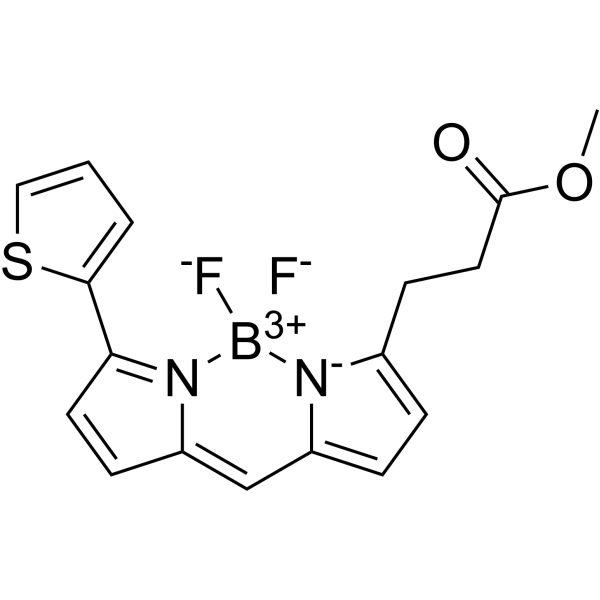
-
- HY-128973
-
-
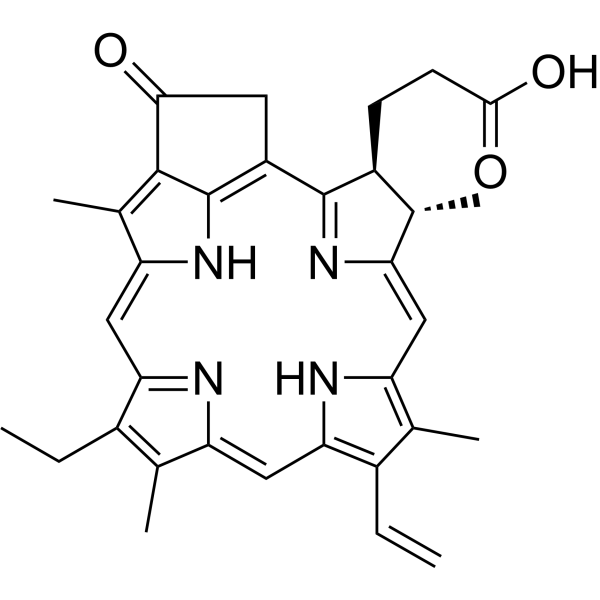
-
- HY-111959
-
-
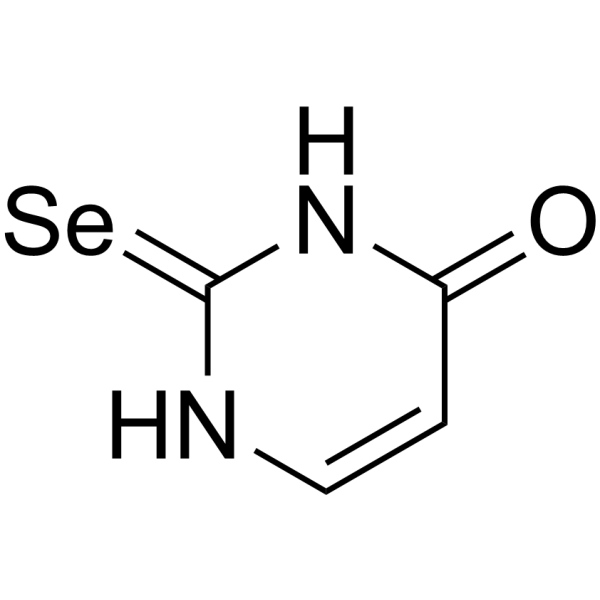
-
- HY-13722
-
HPPH
3 Publications Verification
Photochlor
|
Reactive Oxygen Species
|
Cancer
|
|
HPPH (Photochlor) is a second generation photosensitizer, which acts as a photodynamic therapy (PDT) agent.
|
-
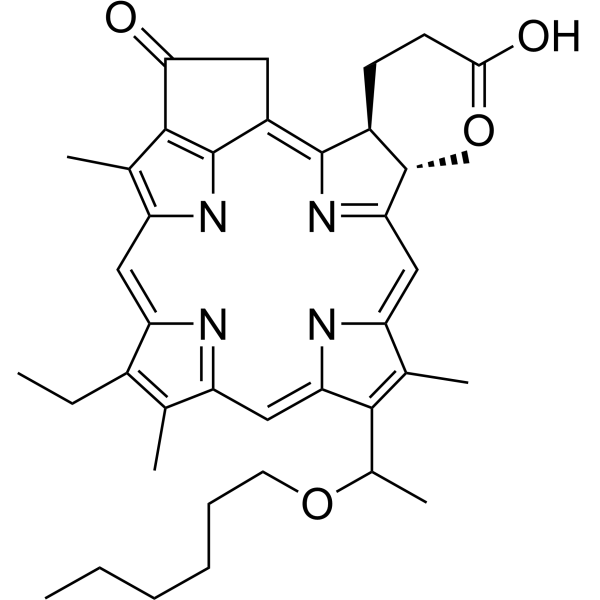
-
- HY-145241
-
|
|
Others
|
Neurological Disease
|
|
TBTDC is a highly efficient multifunctional organic photosensitizer with aggregation-induced emission for in vivo bioimaging and photodynamic research.
|
-

-
- HY-N10611
-
|
|
Reactive Oxygen Species
Apoptosis
Autophagy
Fungal
Fluorescent Dye
|
Infection
Cancer
|
|
Elsinochrome A is a perylene quinone photosensitizer, and can generate reactive oxygen species (ROS) to induce apoptosis and autophagy under light excitation. Elsinochrome A also shows antifungal activity against C. albicans biofilm through photodynamic antimicrobial chemotherapy (PACT). Elsinochrome A can be used for research of photodynamic therapy (PDT) (Ex: 460 nm) .
|
-
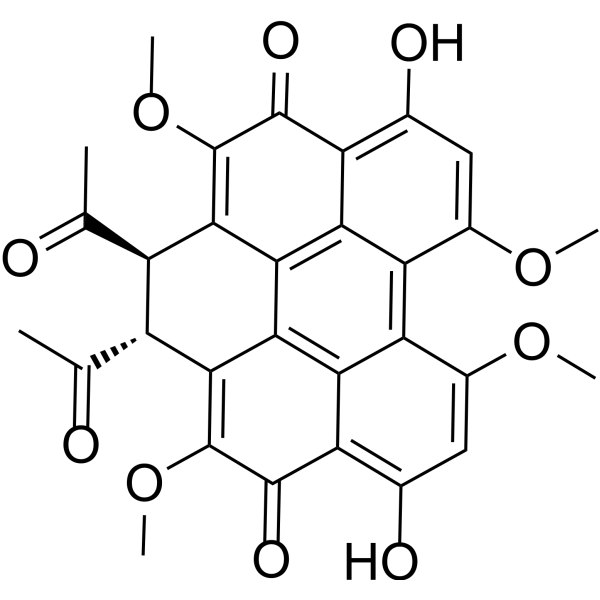
-
- HY-151486
-
|
|
GLUT
|
Cancer
|
|
GLUT1-IN-1 is a glucose transporter 1 (GLUT1) inhibitor and has a GLUT1-specific inactivation ability. GLUT1-IN-1 exhibits concentration-dependent cytotoxicity for HeLa, A549 and HepG2 cells with IC50 values of 5.49 μM, 11.14 μM, and 8.73 μM, respectively. GLUT1-IN-1 can be used for the research of photodynamic therapy (PDT) and severals cancer .
|
-
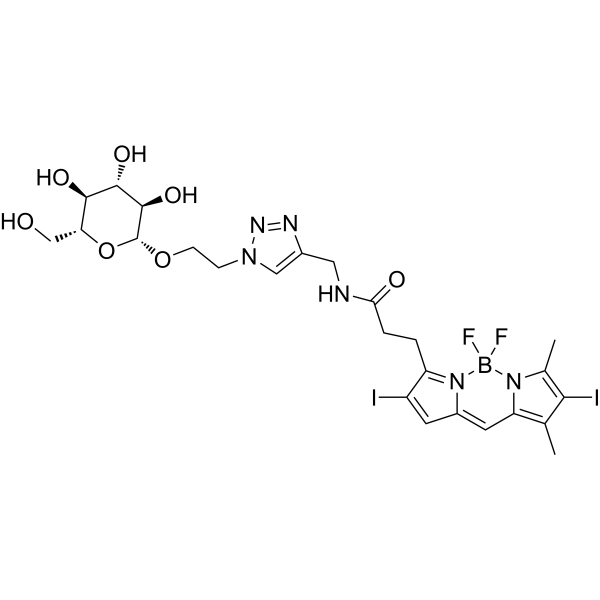
-
- HY-A0169A
-
|
|
|
|
|
Methyl aminolevulinate hydrochloride is an agent used as a sensitizer in photodynamic therapy (PDT). Methyl aminolevulinate is a proagent that can be metabolized to Protoporphyrin IX .
|
-
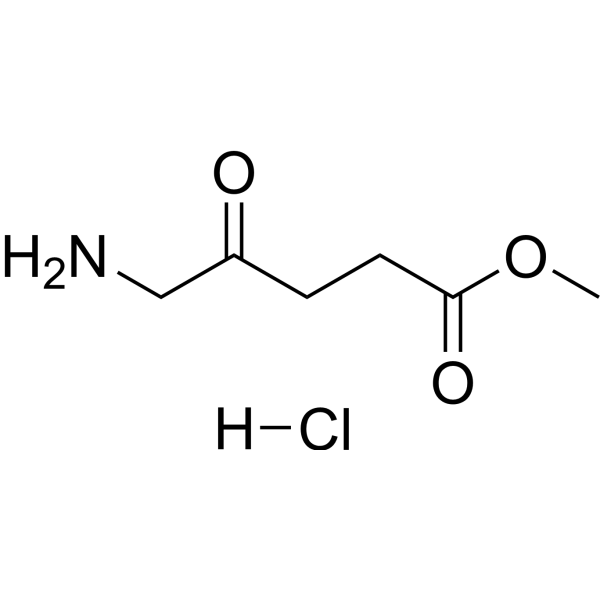
-
- HY-A0169
-
|
|
|
|
|
Methyl aminolevulinate is an agent used as a sensitizer in photodynamic therapy (PDT). Methyl aminolevulinate is a proagent that can be metabolized to Protoporphyrin IX .
|
-
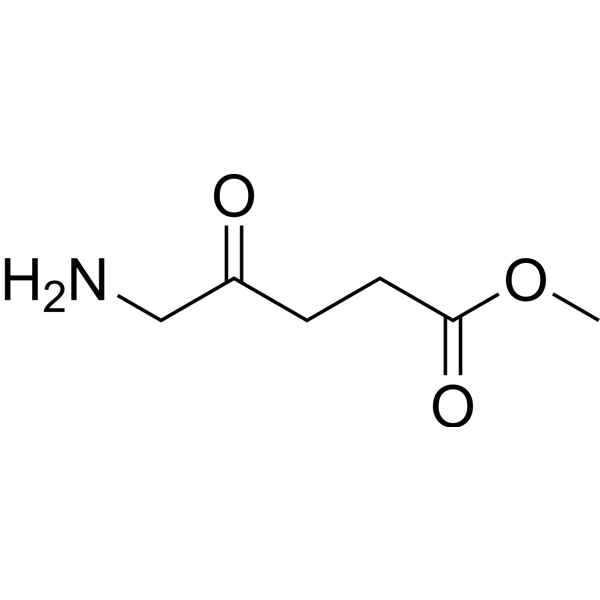
-
- HY-19204
-
|
ZnPc
|
Fluorescent Dye
|
Cancer
|
|
Zinc phthalocyanine is commonly applied in industry (catalysts, photoconductors) and biomedical (photodynamic therapy, PDT) . Zinc phthalocyanine can be used to photooxidise cyclohexane .
|
-

-
- HY-163034
-
|
|
Apoptosis
Reactive Oxygen Species
|
Cancer
|
|
Antitumor photosensitizer-5 (Ru2) is a photosensitizer which effectively target tumor mitochondria with an IC50 of 0.3 μM for phototoxicity to A549 cells. Under 460 nm light irradiation, antitumor photosensitizer-5 induces the generation of reactive oxygen species and NADH depletion, causes mitochondrial damage and activation of caspase-3, inducing apoptosis and suppressing cell migration. Antitumor photosensitizer-5 has the potential to prevent the growth of malignant tumors, therefore, shows the potential to be applied to photodynamic therapy .
|
-

-
- HY-157943
-
|
HAL
|
Fluorescent Dye
|
Cancer
|
|
Hexyl 5-aminolevulinate (HAL) is a photosensitizer, and can increase the efficiency of PDT due to the high lipophilicity. Hexyl 5-aminolevulinate can be used for research of photodynamic therapy (PDT) .
|
-

-
- HY-13547
-
|
|
Apoptosis
|
Cancer
|
|
ADPM06, a lead candidate azadipyrromethene, is a novel nonporphyrin photodynamic therapeutic (PDT) agent. ADPM06 exhibits IC50 values in the micro-molar range in human tumor cells and induces apoptosis .
|
-
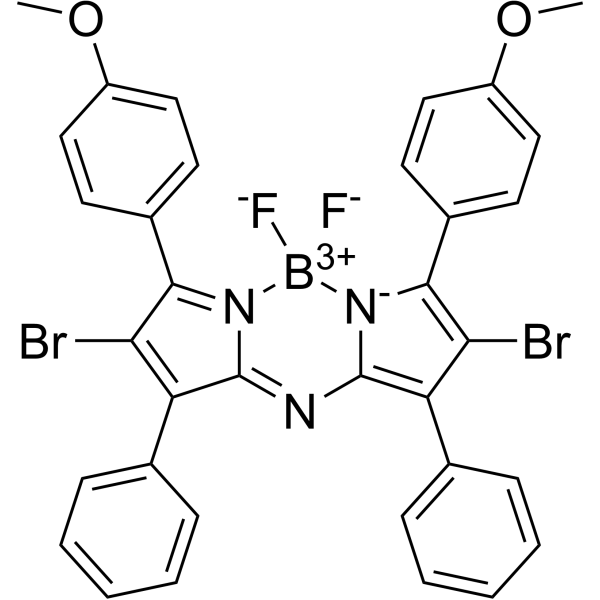
-
- HY-N2575
-
|
|
PKC
Bacterial
Parasite
|
Infection
Cancer
|
|
Hypocrellin A, a naturally occurring PKC inhibitor, has many biological and pharmacological properties, such as antitumour, antiviral, antibacterial, and antileishmanial activities. Hypocrellin A is a promising photosensitizer for anticancer photodynamic therapy (PDT) .
|
-
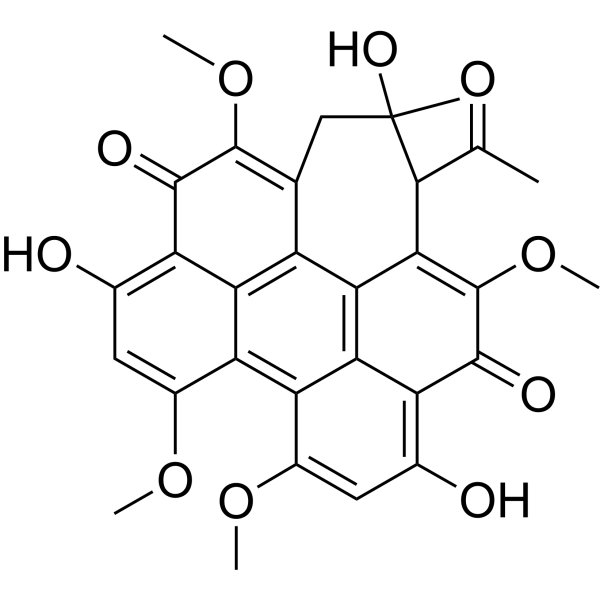
-
- HY-N1453
-
|
|
|
|
|
Hypocrellin B, a pigment isolated from the fungi Hypocrella bambusae and Shiraia bambusicola, is an apoptosis inducer. Hypocrellin B can be used as a photosensitizer for photodynamic therapy of cancer. Hypocrellin B also has antimicrobial and antileishmanial activities .
|
-
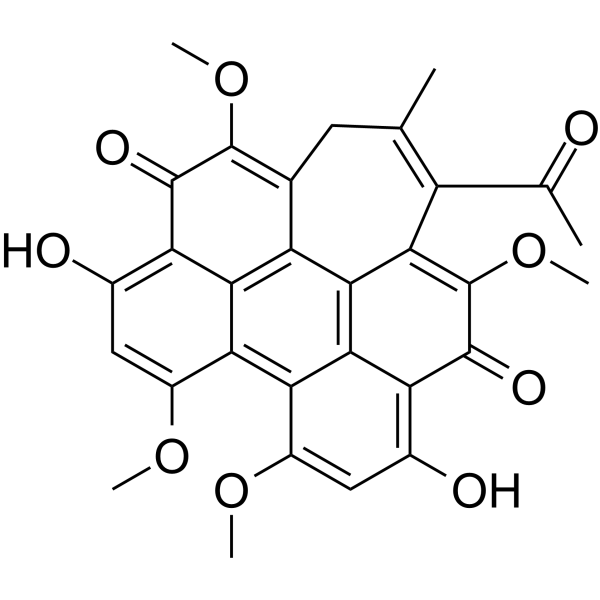
-
- HY-W020768
-
|
|
Biochemical Assay Reagents
|
Cancer
|
|
Fullerene-C60, a representative of carbon nanocompounds, is suggested to be promising agent for application in photodynamic research due to its unique physicochemical properties. Fullerene-C60 probes the intramolecular dynamics of its electron and energy transfer .
|
-
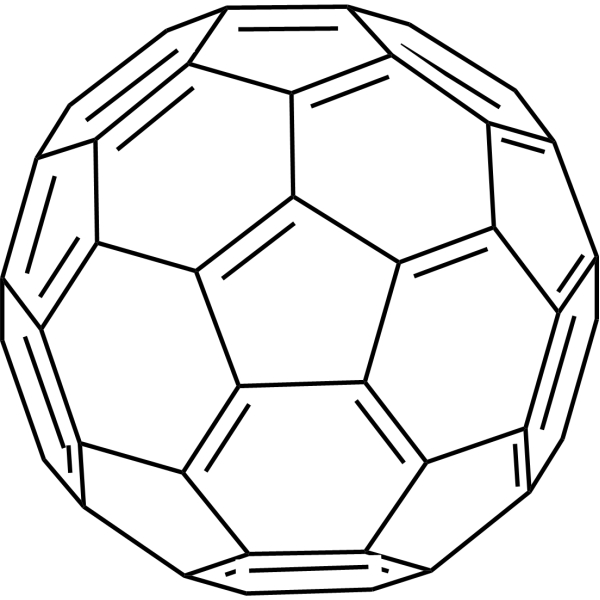
-
- HY-W127725
-
|
|
Biochemical Assay Reagents
|
Others
|
|
Thymolphthalexon (tetrasodium) is an organic compound commonly used as a reagent in biochemical assays. It belongs to the family of thioxanthone derivatives and has strong antioxidant properties. Thymolphthalexon has several applications in the study of free radical response, oxidative stress, and aging. In addition, it can be used as a photosensitizer in photodynamic therapy for the improvement of cancer and other diseases.
|
-
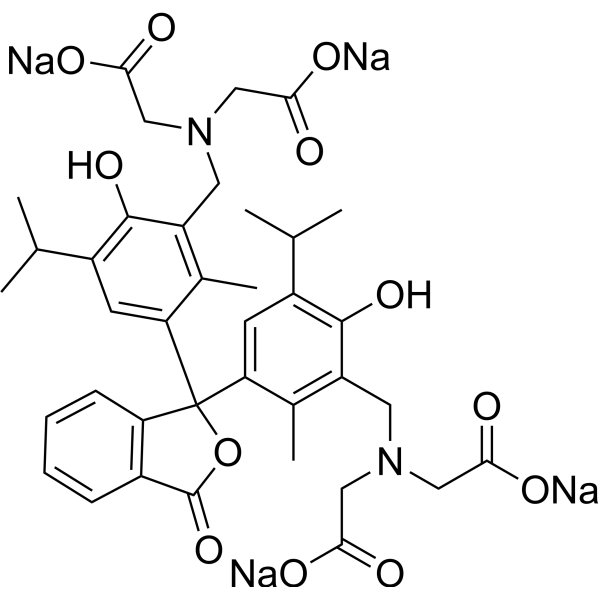
-
- HY-P2213
-
|
|
MMP
Apoptosis
|
Cancer
|
|
GPLGIAGQ, a MMP2-cleavable polypeptide, is used as a stimulus-sensitive linker in both liposomal and micellar nanocarriers for MMP2-triggered tumor targeting. GPLGIAGQ can be used to synthesis unique MMP2-targeted photosensitizer in photodynamic therapy (PDT) .
|
-
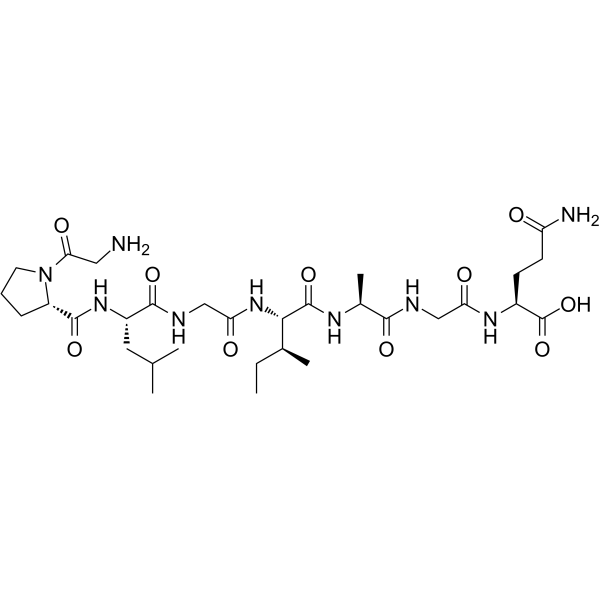
-
- HY-B0146
-
Verteporfin
Maximum Cited Publications
142 Publications Verification
CL 318952
|
YAP
Apoptosis
Autophagy
|
Cancer
|
|
Verteporfin (CL 318952) is a photosensitizer for photodynamic therapy to eliminate the abnormal blood vessels in the eye associated with conditions such as age-related macular degeneration. Verteporfin is a YAP inhibitor which disrupts YAP-TEAD interactions. Verteporfin induces cell apoptosis . Verteporfinis an autophagy inhibitor that blocks autophagy at an early stage by inhibiting autophagosome formation .
|
-

-
- HY-N6743
-
|
|
PKC
|
Cancer
|
|
Cercosporin is produced by a plant pathogen, Pseudocercosporella capsellae. Cercosporin is a potent photosensitizer with a short activation wavelength, mostly suitable for superficial photodynamic therapy (PDT) treatments, especially when it is necessary to avoid perforations .
Cercosporin contains the perylenequinone structural features necessary to PKC activity with an IC50 of 0.6-1.3 μM .
|
-
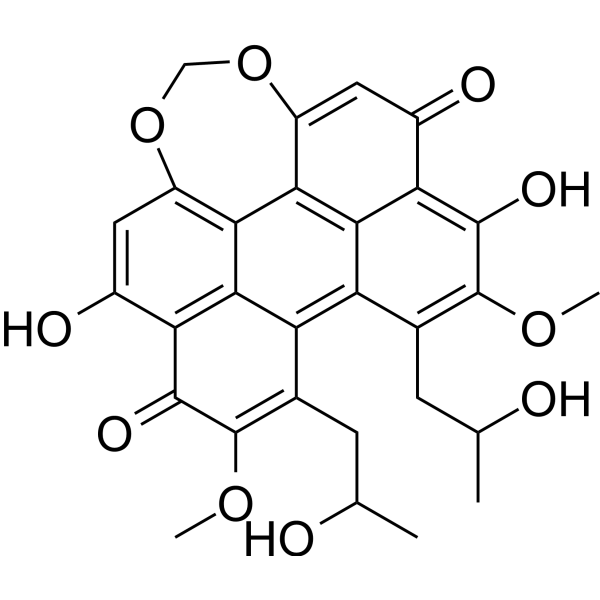
-
- HY-P2213A
-
|
|
MMP
Apoptosis
|
Cancer
|
|
GPLGIAGQ TFA, a MMP2-cleavable polypeptide, is used as a stimulus-sensitive linker in both liposomal and micellar nanocarriers for MMP2-triggered tumor targeting. GPLGIAGQ TFA can be used to synthesis unique MMP2-targeted photosensitizer in photodynamic therapy (PDT) .
|
-
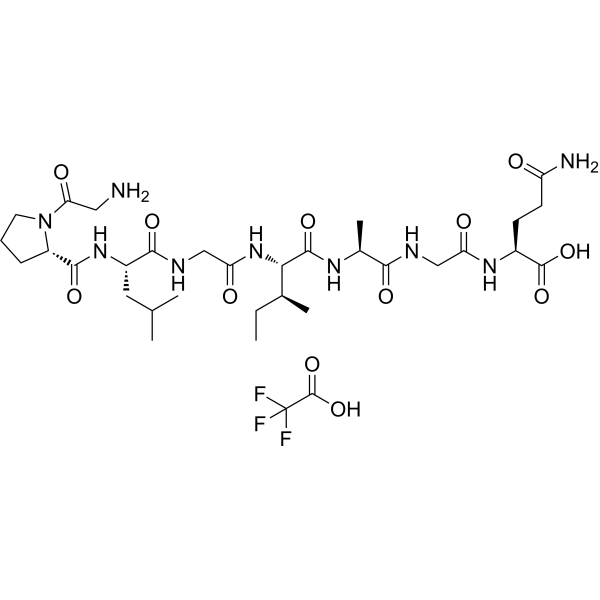
-
- HY-W127805
-
|
|
Biochemical Assay Reagents
|
Others
|
|
Pentacarboxylporphyrin I dihydrochloride is an organic compound belonging to the family of porphyrin derivatives. It is commonly used in biochemical research as a reference standard for the quantification of porphyrins and related compounds in biological samples. Pentacarboxylporphyrin I dihydrochloride has several applications in the diagnosis and monitoring of porphyrias, a group of inherited disorders characterized by abnormalities in heme metabolism. In addition, it can be used as a photosensitizer in photodynamic therapy for the improvement of cancer and other diseases.
|
-
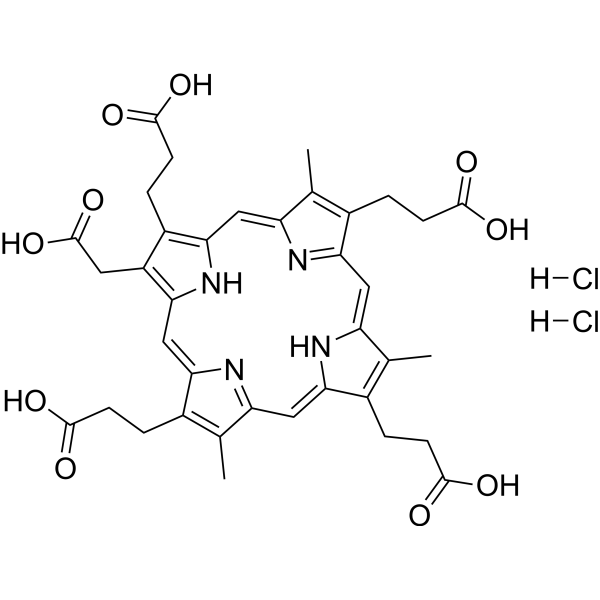
-
- HY-W127809
-
|
|
Biochemical Assay Reagents
|
Others
|
|
Chlorin e4 is an organic compound belonging to the family of chlorins, which are macrocyclic compounds with a similar structure to porphyrins. It is commonly used to improve photodynamic therapy for cancer and other diseases. Chlorin e4 has multiple applications in medical research, including as a photosensitizer for localized tumor destruction. In addition, its antimicrobial properties and potential use in disinfection applications were investigated.
|
-

-
- HY-161341
-
|
|
Others
|
Cancer
|
|
β-Glucuronidase responsive conjugate 1 (compound 3) is a well-balanced photosensitizer which has photodynamic activity. β-Glucuronidase responsive conjugate 1 inhibits T-24 cell viability and growth with an IC50 of 0.2 μM. β-Glucuronidase responsive conjugate 1 can used to study bladder cancers .
|
-
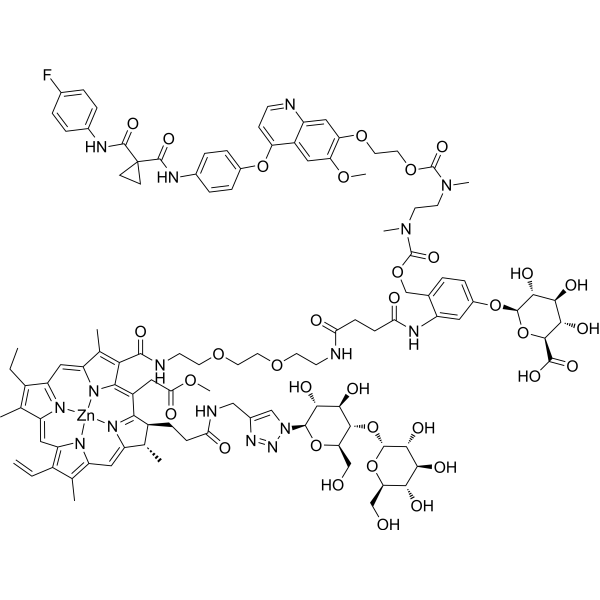
-
- HY-103656
-
|
TPP; Tetraphenylporphine; meso-Tetraphenylporphyrin
|
Others
|
Cancer
|
|
Tetraphenylporphyrin (TPP) is a symmetrically substituted porphyrin-based heterocyclic compound and used as a structural block for supramolecular synthesis. Tetraphenylporphyrin derivatives can be used for cancer research .
|
-

-
- HY-155003
-
|
|
Fluorescent Dye
|
Cancer
|
|
TPEQM-DMA is a NIR-II photosensitizer. TPEQM-DMA accumulates in cancerous mitochondria, and inhibits cancer cell growth. TPEQM-DMA has potent type-I phototherapeutic efficacy to overcome the intrinsic pitfalls of PDT in combating hypoxic tumors .
|
-
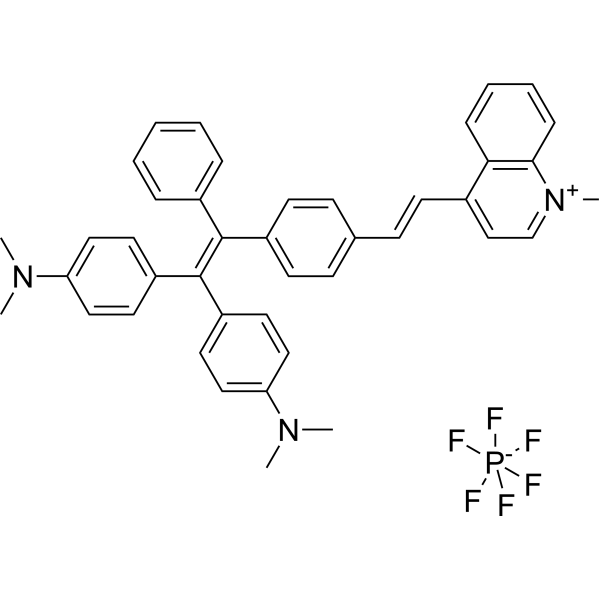
-
- HY-B0146R
-
|
CL 318952 (Standard)
|
YAP
Apoptosis
Autophagy
|
Cancer
|
|
Verteporfin (Standard) is the analytical standard of Verteporfin. This product is intended for research and analytical applications. Verteporfin (CL 318952) is a photosensitizer for photodynamic therapy to eliminate the abnormal blood vessels in the eye associated with conditions such as age-related macular degeneration. Verteporfin is a YAP inhibitor which disrupts YAP-TEAD interactions. Verteporfin induces cell apoptosis . Verteporfinis an autophagy inhibitor that blocks autophagy at an early stage by inhibiting autophagosome formation .
|
-
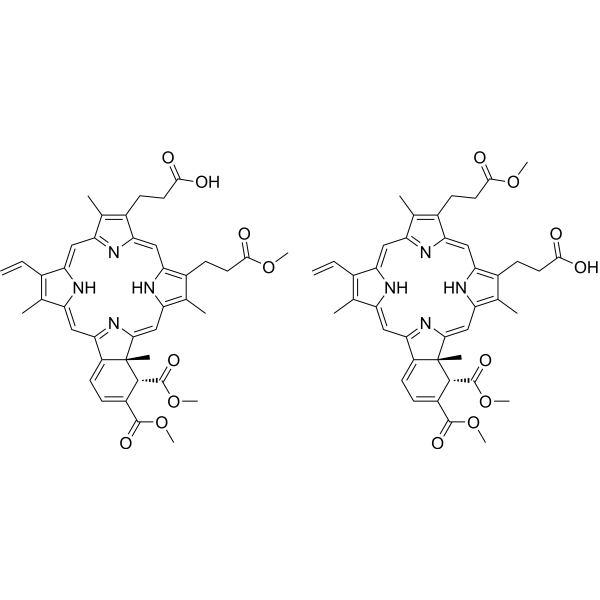
-
- HY-149778
-
|
|
Fungal
|
Infection
|
|
Antifungal agent 87(10) acts as a highly potent PDT antimycotic photosensitizer (PDT-IC50 = 1 nM for T. rubrum) .
|
-
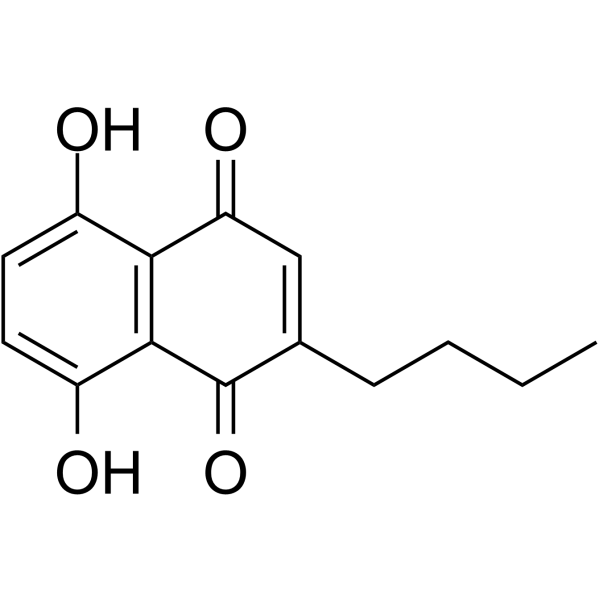
-
- HY-W441016
-
|
|
Biochemical Assay Reagents
|
Others
|
|
DSPE-PEG-NHS, MW 5000 is a pegylated phospholipid derivatives which can be used to prepare liposome or lipid nanoparticles for targeted drug delivery system, such as DNA or mRNA vaccine .
|
-
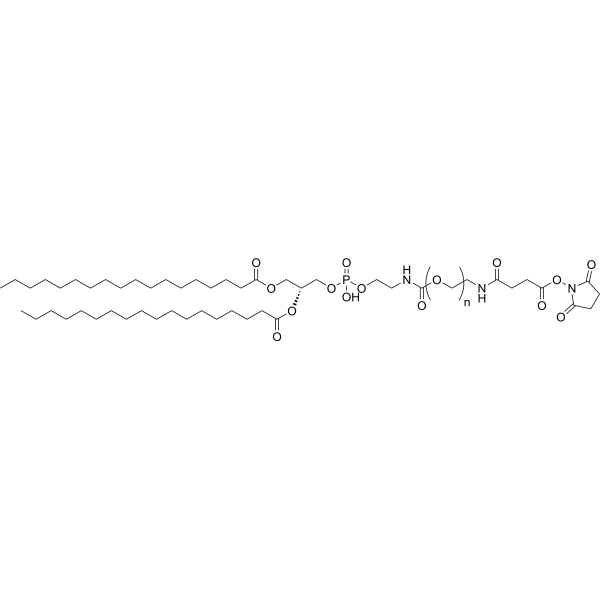
-
- HY-W127820
-
|
Tetrakis(2-N-methylpyridyl)porphine chloride
|
Biochemical Assay Reagents
Fluorescent Dye
|
Others
|
|
H2TMpyP-2 (tetrakis(2-N-methylpyridyl)porphine) chloride is an active photosensitizer with strong absorption properties in the visible to near-infrared region and excellent singlet oxygen quantum yield. Captisol-TMPyP complexes can be used in supramolecular nanosynthesis to increase singlet oxygen production, improve photostability and better photosensitization, and support photodynamic therapy activity. The Captisol:TMPyP complex also exhibited antibacterial activity against Escherichia coli and was cytotoxic against lung cancer A549 cells .
|
-
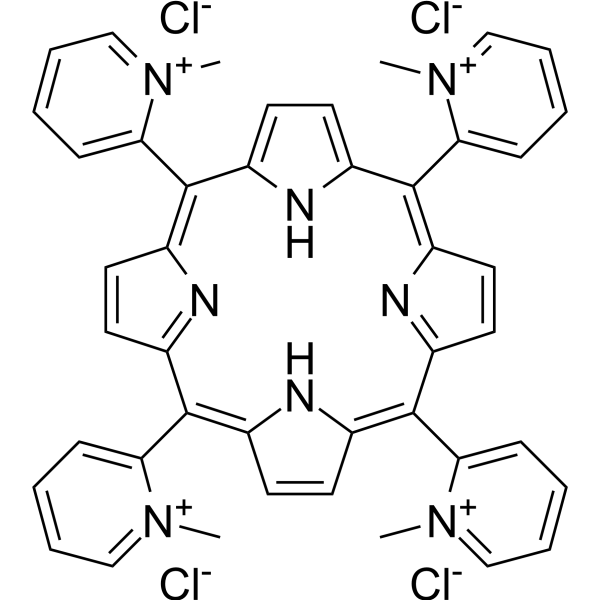
-
- HY-D1658
-
|
|
Fluorescent Dye
|
Others
|
|
BDP 581/591 amine hydrochloride is a BODIPY dye linker. BDP 581/591 is a universal, photostable fluorophore. The addition of the amine group allows for the compound to react with carboxylic acids, activated NHS esters and other carbonyl groups .
|
-

- HY-156092
-
|
|
BCRP
Apoptosis
|
Cancer
|
|
Antitumor photosensitizer-4 (compound 10b) is a potent tyrosine kinase inhibitor (TKI) targeting ABCG2. Antitumor photosensitizer-4 is a photosensitizer (PS) consisting of a conjugate of dasatinib (HY-10181) and imatinib (HY-15463). Antitumor photosensitizer-4 induces apoptosis and ROS production and exhibits strong phototoxicity to HepG2 and B16-F10 cells .
|
-
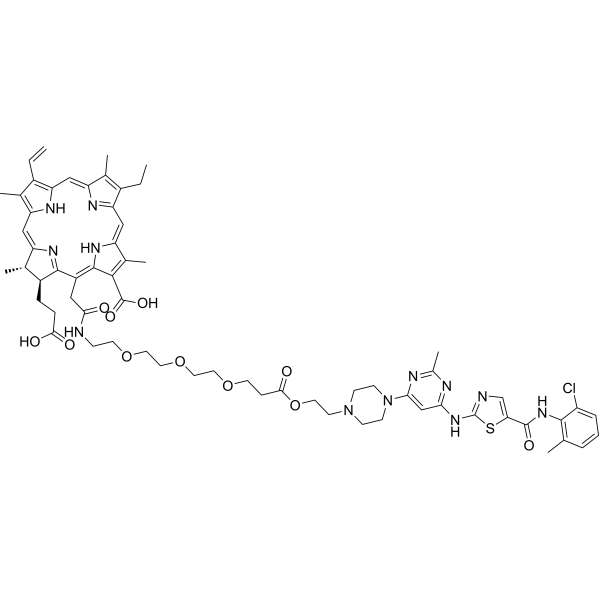
- HY-134990
-
|
|
Apoptosis
|
Cancer
|
|
Hematoporphyrin monomethyl ether, second generation of porphyrin-related photosensitizer, is characterized by its single form, high yield of singlet oxygen, high selectivity, and low toxicity, which has been widely used in the diagnosis and research of various tumors, including lung cancer, bladder cancer, and nevus flammeus and brain glioma .
|
-
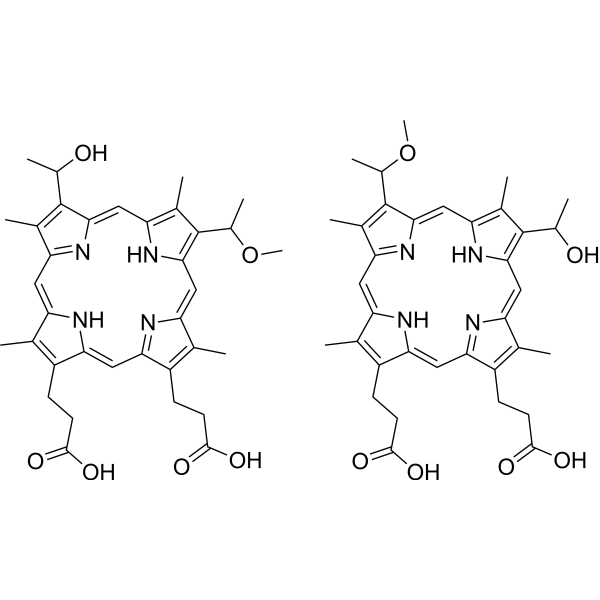
- HY-147690
-
|
|
Others
|
Cancer
|
|
Photosensitizer-2 (compound 1) is a organic D-π-A sensitizer against phototoxicity. Photosensitizer-2 contains an acrylic acid moiety that exerts high levels of phototoxicity. Photosensitizer-2 shows antitumor activity against HeLa cells, with IC50 values of 20.9 ± 4.5 μM (dark) and 0.046 ± 0.012 μM (irradiation), respectively .
|
-
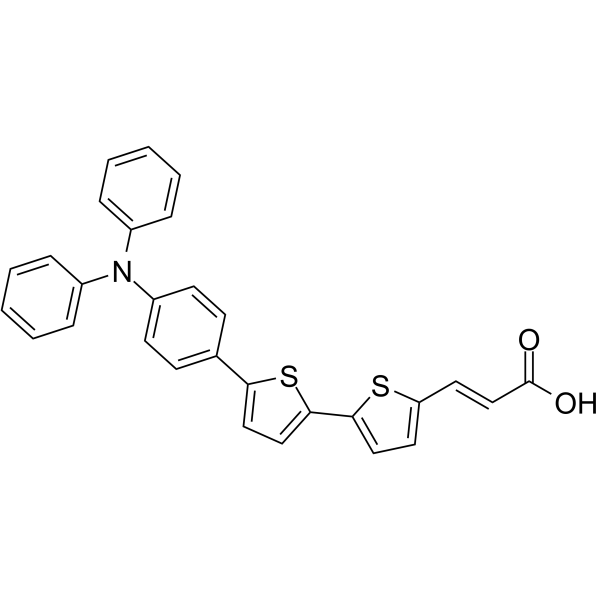
| Cat. No. |
Product Name |
Type |
-
- HY-19204
-
|
ZnPc
|
Dyes
|
|
Zinc phthalocyanine is commonly applied in industry (catalysts, photoconductors) and biomedical (photodynamic therapy, PDT) . Zinc phthalocyanine can be used to photooxidise cyclohexane .
|
-
- HY-D1299
-
|
CF3-substituted Tetramethyl BODIPY
|
Fluorescent Dyes/Probes
|
|
meso-CF3-BODIPY 2 (CF3-substituted Tetramethyl BODIPY) is a fluorescent dye with the absorption wavelength (λabs) of 553 nm and emission wavelength (λem) of 622 nm. meso-CF3-BODIPY 2 can be used in labeling reagents and photodynamic therapy .
|
-
- HY-D1591
-
|
|
Fluorescent Dyes/Probes
|
|
BODIPY R6G methyl ester (compound 5′-1) is a BODIPY-like fluorescent dye with good light stability and insensitive to pH value. BODIPY R6G methyl ester shows good photostability, high sensitivity and insensitive to pH value. BODIPY R6G methyl ester can be used in research areas such as photodynamic research, PH probes, ion recognition, photocatalysis, protein labeling, cell imaging, and proteomic analysis .
|
-
- HY-162129
-
|
|
Fluorescent Dyes/Probes
|
|
Antitumor agent-131 (Compound 2-p) is an ER fluorescent probe with an IC50 value of 23 nM for HepG2 tumor cells. Antitumor agent-131 can be used as a photosensitizer for the study of cancer photodynamics .
|
-
- HY-W127725
-
|
|
Dyes
|
|
Thymolphthalexon (tetrasodium) is an organic compound commonly used as a reagent in biochemical assays. It belongs to the family of thioxanthone derivatives and has strong antioxidant properties. Thymolphthalexon has several applications in the study of free radical response, oxidative stress, and aging. In addition, it can be used as a photosensitizer in photodynamic therapy for the improvement of cancer and other diseases.
|
-
- HY-D1658
-
|
|
Fluorescent Dyes/Probes
|
|
BDP 581/591 amine hydrochloride is a BODIPY dye linker. BDP 581/591 is a universal, photostable fluorophore. The addition of the amine group allows for the compound to react with carboxylic acids, activated NHS esters and other carbonyl groups .
|
| Cat. No. |
Product Name |
Type |
-
- HY-W141871
-
|
|
Biochemical Assay Reagents
|
|
DL-Thyronine protects trypsin from photodynamic inactivation sensitized by Riboflavin-5'-phosphate (FMN) .
|
-
- HY-W127805
-
|
|
Biochemical Assay Reagents
|
|
Pentacarboxylporphyrin I dihydrochloride is an organic compound belonging to the family of porphyrin derivatives. It is commonly used in biochemical research as a reference standard for the quantification of porphyrins and related compounds in biological samples. Pentacarboxylporphyrin I dihydrochloride has several applications in the diagnosis and monitoring of porphyrias, a group of inherited disorders characterized by abnormalities in heme metabolism. In addition, it can be used as a photosensitizer in photodynamic therapy for the improvement of cancer and other diseases.
|
-
- HY-W127809
-
|
|
Biochemical Assay Reagents
|
|
Chlorin e4 is an organic compound belonging to the family of chlorins, which are macrocyclic compounds with a similar structure to porphyrins. It is commonly used to improve photodynamic therapy for cancer and other diseases. Chlorin e4 has multiple applications in medical research, including as a photosensitizer for localized tumor destruction. In addition, its antimicrobial properties and potential use in disinfection applications were investigated.
|
| Cat. No. |
Product Name |
Target |
Research Area |
-
- HY-P2213A
-
|
|
MMP
Apoptosis
|
Cancer
|
|
GPLGIAGQ TFA, a MMP2-cleavable polypeptide, is used as a stimulus-sensitive linker in both liposomal and micellar nanocarriers for MMP2-triggered tumor targeting. GPLGIAGQ TFA can be used to synthesis unique MMP2-targeted photosensitizer in photodynamic therapy (PDT) .
|
-
- HY-P2213
-
|
|
MMP
Apoptosis
|
Cancer
|
|
GPLGIAGQ, a MMP2-cleavable polypeptide, is used as a stimulus-sensitive linker in both liposomal and micellar nanocarriers for MMP2-triggered tumor targeting. GPLGIAGQ can be used to synthesis unique MMP2-targeted photosensitizer in photodynamic therapy (PDT) .
|
| Cat. No. |
Product Name |
Category |
Target |
Chemical Structure |
| Cat. No. |
Product Name |
|
Classification |
-
- HY-162129
-
|
|
|
Azide
|
|
Antitumor agent-131 (Compound 2-p) is an ER fluorescent probe with an IC50 value of 23 nM for HepG2 tumor cells. Antitumor agent-131 can be used as a photosensitizer for the study of cancer photodynamics .
|
Your information is safe with us. * Required Fields.
Inquiry Information
- Product Name:
- Cat. No.:
- Quantity:
- MCE Japan Authorized Agent:


















2](http://file.medchemexpress.com/product_pic/hy-157053.gif)
![[Ru(DIP)2TAP]Cl2](http://file.medchemexpress.com/product_pic/hy-157051.gif)









































